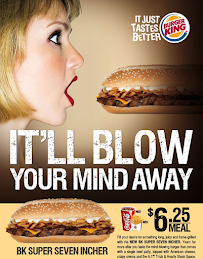1)
2)
3) In the 1950s/1960s adverts, women are portrayed to be cleaning, cooking or looking after their husband and/or family. This supports the certain stereotype that they are only good for being a housewife; and that their only role is to be a mother and look after their home and family. Also, some of the adverts convey hugely stereotypical messages, for example: "She'll be happier with a hoover". This implies that women are not only labelled as housewives, but that is what their whole personality and being is made out to be. Another way in which women are shown in the 1950s/1960s adverts are with a man, however they are depicted to seem inferior or of less value than men, who are clearly the dominant figure within every advert featuring both a man and a women. This is shown in the example: "Blow in her face and she'll follow you anywhere". This slogan indicates that women have to depend on a man completely and are incapable of relying on themselves; it also expresses the idea that men have "control" over a women and what she does, again presented by the phrase 'she'll follow you anywhere'. Furthermore, this advert suggests that back then women were always seen as subservient and fully lenient on men, in some cases they were also sexualised or portrayed in a way which made them seem as more like objects, rather than actual real people.
4) In the post-2000s adverts, women are represented through advertising in a better light compared to the 1950s/1960s adverts. However, in some cases they are still objectified in a way, or conveyed as society's "beauty standards" in which are believed to be how a women should look or present herself. Some of these beauty standards include being slim or well-defined, lighter hair (e.g. blonde), blue eyes and more. These are displayed through many women's adverts, for example the Burger King advert (included in Q2). In this advert, the women is shown to be a thin and blonde with white skin which again links back to society's expectations of a women's appearance. She is also shown wearing an excessive amount of make-up, including a very deep shade of red lipstick which could be seen as a "sexual" colour. Additionally, it suggests that the focus of women in these adverts is solely based on their appearances rather than adding a more meaningful message to them, as they are also portrayed to be wearing overly revealing clothes in most of them. This could come across as very stereotypical towards women, indicating that though they are not always portrayed to be "housewives or mothers" as opposed to the 1950s/1960s adverts, not as much has changed in terms of how their appearances are presented throughout more recent adverts.
5) Over the last 60 years, representations of gender have changed in a number of ways post-2000 compared to the 1950s and 1960s. For example, in the 1950s/1960s, women were always portrayed in a hugely stereotypical way; either cleaning, cooking or looking after their husband/family - they were implied to be inferior and fully dependent on their husband. However, in post-2000 adverts, many of the roles were reversed - men are now also seen to be cooking or taking care of their family whilst women are seen to be working or doing things that they wouldn't have been able to do beforehand, one of them being martial arts (shown in the third advert in Q2). Overall, the portrayal of both genders within more recent adverts has changed significantly compared to adverts from 60 years ago, with most of the changes being in very positive ways.









No comments:
Post a Comment